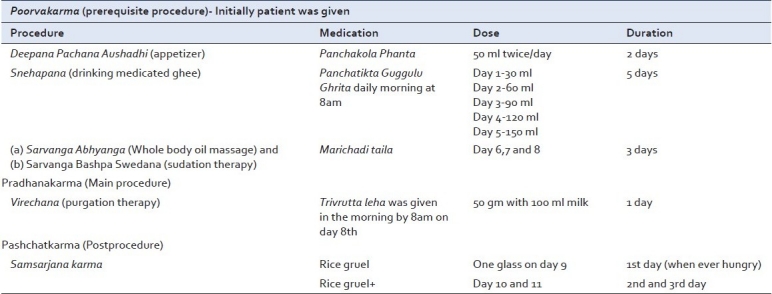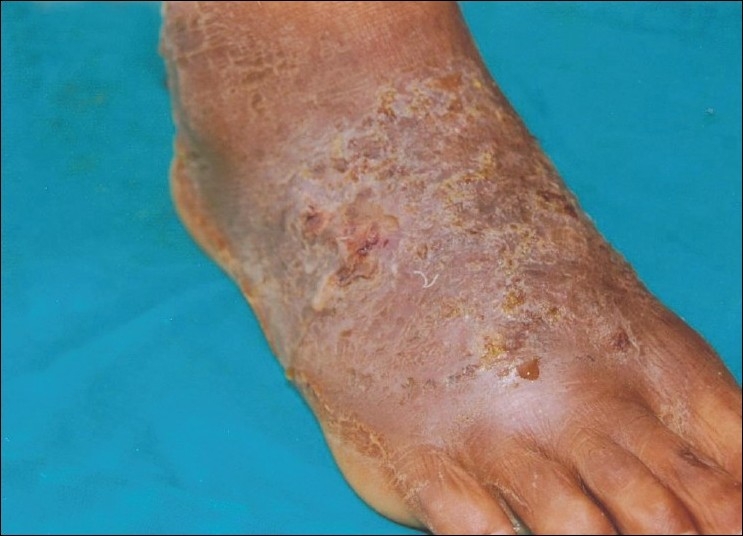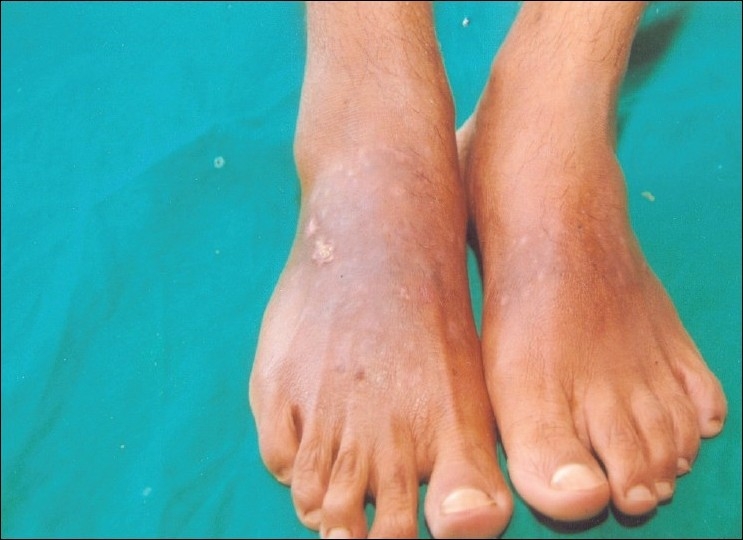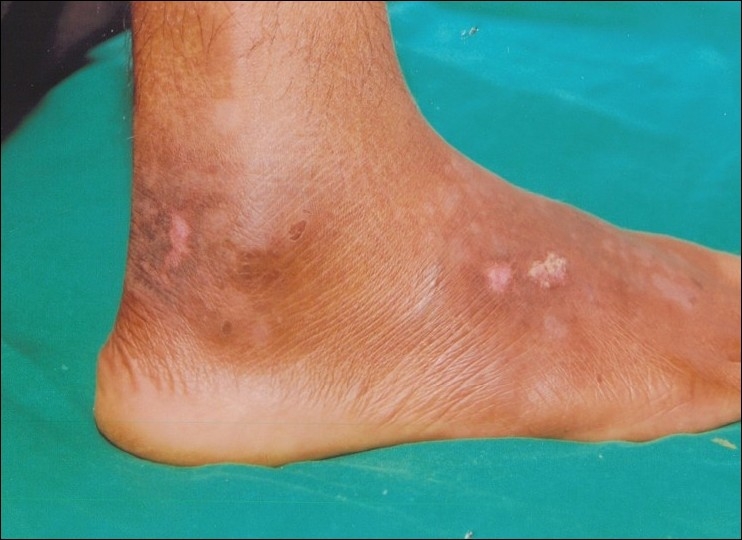Abstract
Eczema is a form of dermatitis where inflammation of epidermis occurs. The exact cause of eczema is not known. Although it is activated by the immune system and is related to allergic reactions, it is not the same as other allergic reactions. In Ayurveda, the disease is described by the name “Vicharchika.” Virechana is the best line of management for skin disorders. Controlling eczema more effectively can make a radical improvement to the patient's quality of life. A case report of 45-year-old male, who presented with complaints of rashes over dorsum of both foot associated with intense itching and burning sensation, oozing wound posterior to lateral malleolus and dorsum of left foot has been presented here.
Keywords: Eczema, vicharchika, virechana
INTRODUCTION
The word eczema comes from the Greek word ekzein meaning “to boil out”; word ek means “out”, while zema means boiling.[1] The exact cause of eczema is not known. People with eczema do have the IgE antibodies (immunoglobulin E) produced by the immune system as part of allergic reactions. Eczema can be a difficult and frustrating condition. The psychological challenge faced by the patients of eczema is insurmountable. The natural human desire to scratch an itchy rash just makes the condition worse.
In 2009 a study carried out by scientists at the University of Edinburgh concluded that the defects in a particular gene known as the filaggrin gene are linked to a considerably amplified risk of developing allergic disorders such as eczema, rhinitis, and asthma.[2] In Ayurveda eczema is a type of Kushta.[3]
CASE REPORT
A 45-year-old male presented with the complaint of rashes over both foot associated with intense itching since 4 years. The patient also complained of oozing from nonhealing wound present posterior to lateral malleolus and dorsum of left foot. (approximately 4 × 3 cm) associated with burning sensation, since 3 years.
There were dry scaly lesions over dorsal aspect of right foot and thick serous discharging wounds posterior to lateral malleolus and dorsum of left foot (approximately 4 Χ 3 cm). A foul smell was present, with a thick serious discharge and mild edema. There was tenderness over the lesions with elevated local temperature and surrounding indurations.
Routine hematology (Hb, TC, DC, ESR) and urine investigations were within normal limits. The skin lesion was sent for culture and sensitivity test and report showed no growth.
The patient was administered classical Virechana (purgation therapy). The details of the procedures are described in Table 1.
Table 1.
Procedures administered to the patient

RESULTS
The features of cellulites improved by 5 days and eczematous changes improved by 1 month leaving some amount of hyper pigmentation over the feet. The patient was advised to wear socks during his work.
With a follow up for a period of 1 year, the patient has shown no signs of recurrence. Meanwhile, he was prescribed oral medication viz Arogyavardhini vati one tablet thrice daily for one month and Panchatiktaka guggulu ghrita 10 ml twice daily, i.e., morning at 7 a.m. and evening 7 p.m. at least 1 h before food with hot water in sips for next 1 month.
DISCUSSION
“Itch that rashes” is characteristic feature of Eczema.[4] The lipid barrier of skin is usually reduced in the people with eczema, compared with others. The lipid barrier helps prevent water loss. As the barrier is reduced water loss will be faster as a result skin becomes dry. The immune system then overreacts to these allergens and causes inflamed, irritated, or sore skin.
MODE OF ACTION
Agnideepaka Aushadhi (appetizer)
Oral administration of certain medicines that augments and assists the process of digestion, thus ensuring the optimal state of GIT. The drugs do the Aamapachana. Deepana Pachana Aushadhi not only improves the digestive capacity, also enhance the metabolic activity of the cells.
Snehapana (drinking medicated ghee)
Administration of medicated ghee is a prerequisite procedure which is carried for specific period of 5–7 days based on the acceptance capacity of patient and symptoms. This helps for the exit of the toxins from the body. It also adds up greasiness to the body. During the process of Snehapana patient was asked to drink sips of warm water until the smell of ghee was lost in his burp (Jeerna Udgara) and felt hungry.
Sarvang Abhanga (whole body oil massage)
Helps to bring the Doshsa (toxins) from all over body (periphery - Shakha) to the excretory channels (center - Koshtha).This is carried for 3 days after Snehapana.
Bashpa Swedana (sudation therapy)
The process of sweating also involves elimination of waste and Dosha (toxins) form the body. These natural functions of sweat are utilized for the therapeutic purposes in Swedana process. Immediately after oil massage, the patient has to undergo sudation therapy by setting in steam chamber until symptoms of proper sweating is present.
Virechana (purgation)
In this procedure, the Doshas (toxins) collected in the excretory channels will be expelled out through anal route. Virechana drugs cause irritation and enhance the motility of the intestinal wall along with excessive secretion, which help in smooth and easy expulsion of Doshas (toxins). Patient was given purgative drugs. The patient purgated for 16 times which is considered as moderate purgation.
Samsarjanakrama (post procedure)
In this procedure, strict bland diet was maintained for 3 days for proper bowel functioning.
The patient had features of cellulites with wound. Care was taken by daily dressing with medicated decoction wash (Panchavalkala Kwath Prakshalana). Panchavalkala Kwath Prakshalana has cleansing as well as healing property.
As the patient was Building constructer by occupation the cause for his eczema was cement (chemical) irritation, hence, it was the clear case of exogenous eczema. This way the patient was monitored for diet, along with purificatiory measures for removal of toxins by purgation therapy. The mental stress of living with eczema can have a psychological impact on the sufferer. So, the patient during the treatment procedure was also counseled and followed Pranayama and Yoga. The patient was managed only on Ayurvedic treatment modalities.
Our main aim is to purify the body by removing the Doshas(toxins) and boost the immune system. Thus enabling the patient to live a healthy and peaceful life.
CONCLUSION
Eczema is a disease having its impact on body as well as on mind. Ayurvedic line of management aims to give a blissful life by improving the immune system of the individual by removing the toxins, and even controlling the mind. Controlling eczema more effectively can make a radical improvement to the patient's quality of life.
Figure 1.

Before treatment
Figure 2.

After treatment
Figure 3.

After treatment
Footnotes
Source of Support: Nil
Conflict of Interest: None declared
REFERENCES
- 1.14th ed. Varanasi: Chaukambha publications; Sushruta samhita - Nidanasthana; by Kaviraj Dr Ambikadattshastri; pp. 247–8. Shloka-5/5,8. [Google Scholar]
- 2.14th ed. Varanasi: Chaukambha publications; Sushruta samhita - Chikitsasthana; by Abhikadattashastri; p. 49. Shloka-9/6. [Google Scholar]
- 3.8th ed. Chapter 26 Chaukambha Publications; Yogaratnakara - Kushtachikitsa Adhyaya; Vidhyotini hindi tika; p. 214,219,224. [Google Scholar]
- 4. [Last accessed on 2010 Jul 25]. Available from: http: //www.emedicinehealth.com .


